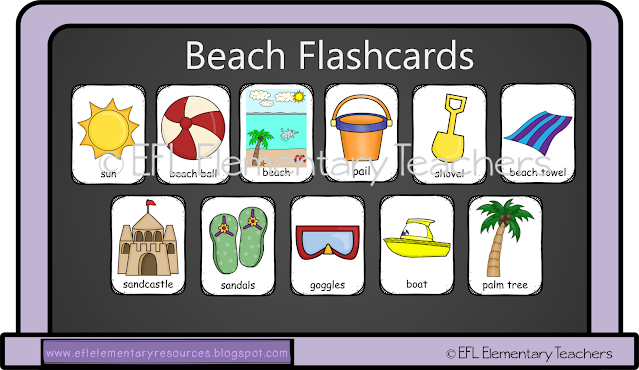Here’s
the link to all the resources:
Watch the video with the resource:
The resource is also available here: https://www.bilingualmarketplace.com/products/beach-unit-for-elementary-esl?variant=37224677245092
Beach Unit Flashcards.
Vocabulary enriches the students’ language. Flashcards are a good strategy to
start with. Display all the flashcards on the board. Point to each beach item and have the students name them.
Teacher: What is this?
Students: It's a beach ball.
Have the students sort the beach items and the nature items.
Do Spelling with students.
Start spelling a word and the students name it and point to that specific
flashcard.
Teacher: s-h-o-v-e-l
Students:
shovel !

Teacher: He can eat a popsicle.
Student: He can play with a beach ball.
Beach
prepositions. Draw a beach scene on the board. Place
the cutouts in the scene.
Teacher: Where is the chair?
Students: It is under the
umbrella.
On the same beach scene, place the children on the
beach and review Verbs.
Teacher: Where are the children?
Students: They are at the
beach.
Teacher: What is he doing?
Students: He is playing
with a beach ball.
Teacher: What are they doing?
Students: They are
swimming.

Students will create their own scene and write a text to describe it. Children can use the
objects and /or the children. The sentences will be on actions or on
prepositions. Then have them show their work.

Have
children work in pairs with their beach scene and ask questions without seeing
each other paper.
Student 1: Is there a beach ball?
Student 2: No, there isn’t.
The student who can guess the most items wins.
Students can also do more writing on these templates and then create a classroom garland for
all the students to read.
Beach
and Numbers. Use the number cards to review numbers
and plurals.
Teacher: What is behind Number 2?
Students: The sun!
Place several Number cards on the board and
have the students draw the items.
Teacher: How many shells are there?
Students: There are 5 blue shells.
Beach
and the alphabet. Same
cards as the numbers to review the alphabet.
Teacher: What is behind letter A?
Students: a beach ball?
Teacher: Where is the crab?
Students: It is on letter B and W.
Book:
The penguins are going on vacation. I
happened to run into this book from when my kids were in Kindergarten. I
thought it be a start for my blog post. If you want the book on pdf request it : (ei98srl@gmail.com)
Here are all the cutouts to use on a flannel board. I made mine out of a
floor cleaning cloth. Use it for retelling the story. I placed Velcro to all
the pieces and it sticks perfectly.
I always wanted a flannel board but making one was a where do I start. I researched and saw this idea of using a mopping cloth. I went to the supermarket and bought this pink one. Yes, pink, the other one was gray. I have bought a yellow one and I am trying to catch a blue one. They are cheap where I live and they are good quality. I went to the tailor and had a border sewn on it and a little hanging hoop. If you make one either for your classroom or home, it is easy to hang and easy to put ways since it is not very big. You don’t have to add the border.
Pick a cute book. I used this book that my kids had at home. I have the pdf for free by request (ei98srl@gmail.com)
I also made a similar book to review the grammar and
vocabulary from the original book, instead of penguins going on vacation I used
frogs. The black and white version has traceable sentences.
And
koalas can also go on vacation. I made puppets to retell the story.
Teacher and students: The koalas are going on vacation. The
koala is going to surf. The koala is going to play with a beach ball. The koala
is going to make a sandcastle. The koala is going to scuba dive. The koala is
going to drive. The kola is going to drink lemonade.
The mouse is going on vacation but on a worksheet. Students complete
the scene of all the things that the mouse is going to do on vacation.
Some Monsters are going on vacation but I made spinners. One spinner has numbers and
the other one has the monsters. The number spinner stands for the amount of
sentences to say or write and the monster is central character of the
sentences.
A simple game: word and picture association.
And a free file! Go to the link and download it. https://www.teacherspayteachers.com/Product/Beach-Numbers-for-Elementary-EFL-4079286
Print the beach numbers cards and use them for speaking opportunities in the classroom.
And print the Sentence association game for the Beach unit Numbers review.
or use as a notebook activity.
There is a bundle with this resource included. Here is the link to check it out.































































